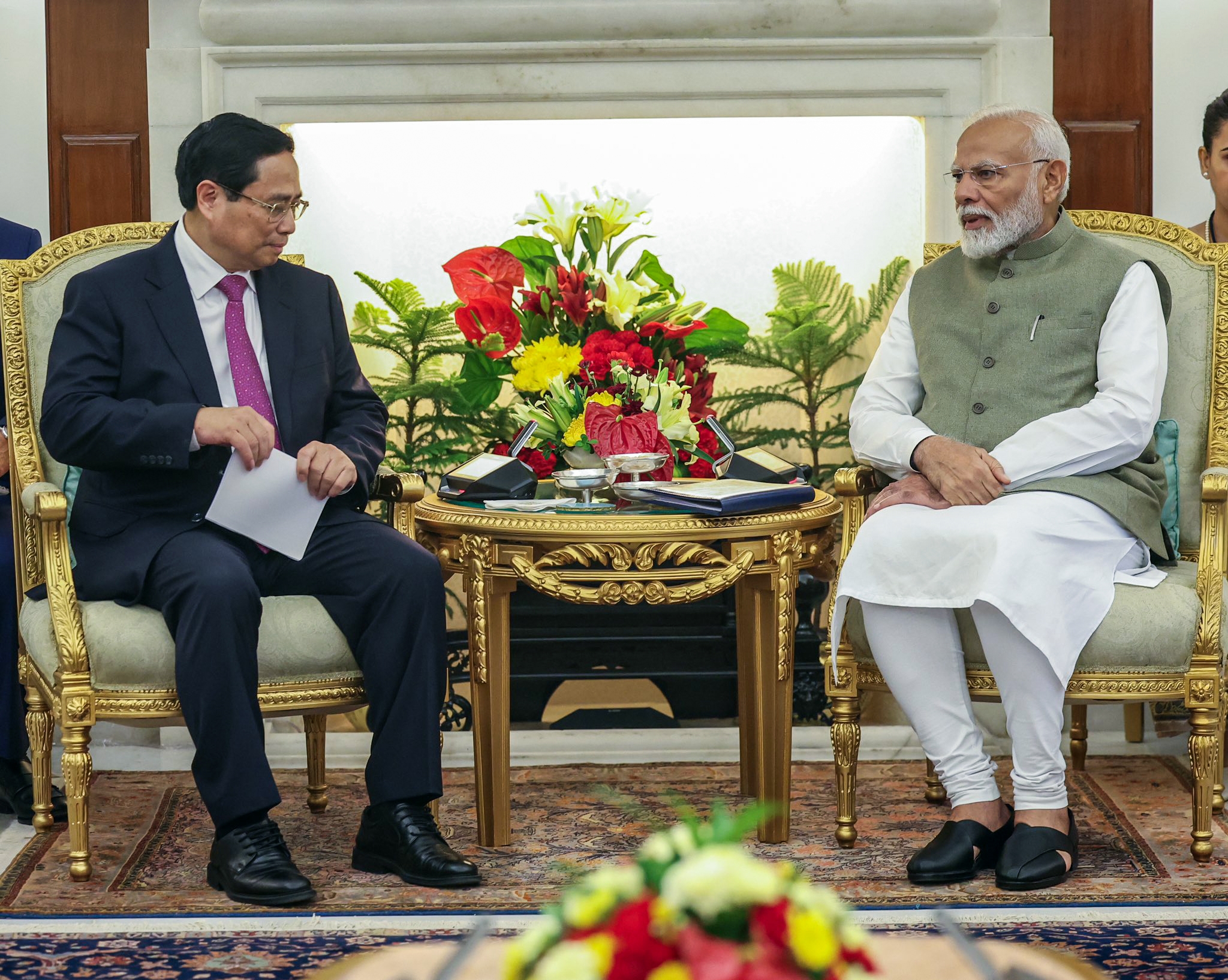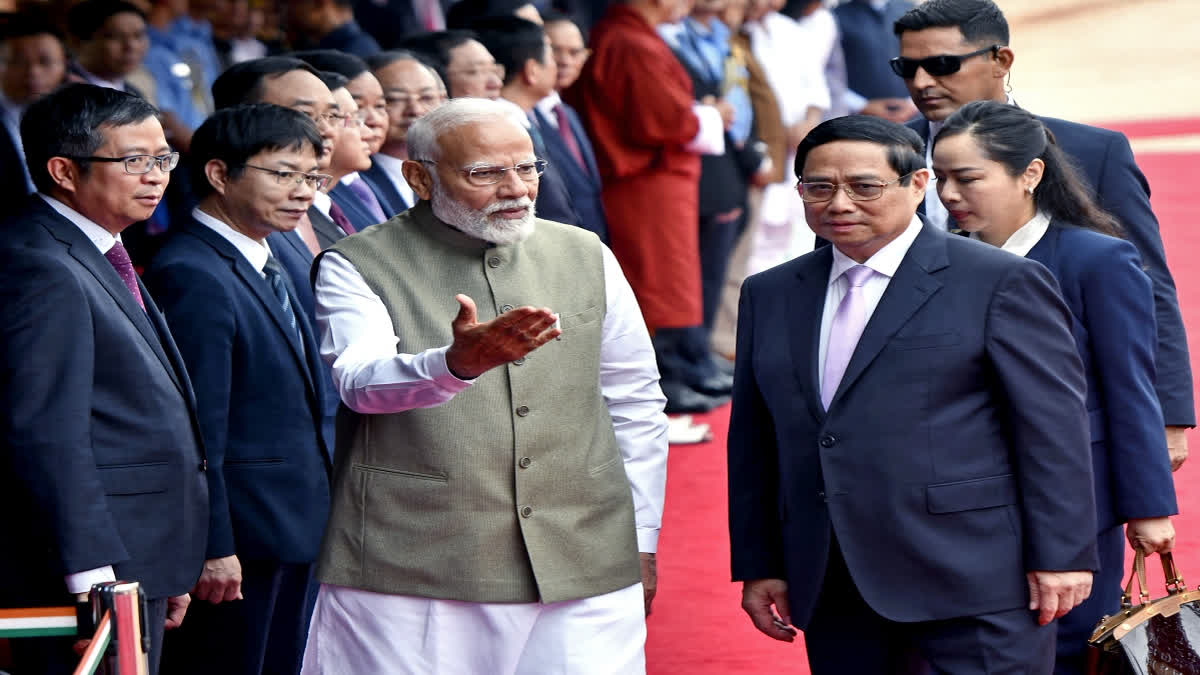In many ways, the latest state visit of Vietnamese Prime Minister Pam Minh Chinh to India has been remarkable. India has just embarked on a new government for the third term and Vietnam is undergoing political churn back home with the death of the general secretary of the ruling Communist Party of Vietnam, replacing Nguyen Phu Trong two weeks ago and the election of Vietnamese President To Lam to the nation's top position. PM Chinh was on a 3-day visit to India between 30 July–1 August.
New Delhi's decision to arrange a rather long state visit on short notice depicts its willingness to engage with Vietnam. Politically, India sent the right signals to Vietnam, a key strategic partner in East Asia which is rapidly emerging as India's geography of choice. On Vietnam's part, PM Chinh came with an intent, evinced by his large delegation comprising Ministers and leaders of many ministries.
A key speech delivered by him at the Indian Council of World Affairs and his interactions with the India Business Forum and Indian businesses are reflective of the emerging key geoeconomics linkages between South and Southeast Asian countries. In both these regions, India and Vietnam have become the nodes of a new economic shift which may be underway.

Rising wage rates in China and a post-pandemic realisation of the downsides of excessive supply chain concentration in one geography has led to a shift of supply chains from China to countries like India and Vietnam. Both these countries are conducive to businesses given their lack of extreme positions of global conflict, non-alignment, low wage rates and governments which are looking to curate a business-friendly environment fostered by rapid economic growth. As such, the primary aim of the visit was to elevate bilateral relations to a new level by strengthening the Comprehensive Strategic Partnership.
The bilateral relations between India and Vietnam was elevated to a Comprehensive Strategic Partnership in 2016 broadening the scope of bilateral ties. Additionally, the India-Vietnam Joint Vision for Peace, Prosperity and People in 2020 has become the fulcrum to which the broader progress of bilateral ties is now tied. Given, the realities of the global order which is evolving rapidly, India and Vietnam have found convergences on many issues. On global issues, including the two ongoing conflicts in Europe and the Middle East, both India and Vietnam have taken similar positions, calling for peace and stability for the region to return. Both New Delhi and Hanoi are also strong advocates for a greater voice of the Global South in international affairs.
As the war in Europe enters a phase of an attrition war and the Israel-Hamas drags on with immense unpredictability, countries, especially middle economic powers, are finding ways to skirt global crises and find ways to broaden engagements. India and Vietnam may well be two of the most foremost representatives in Asia of that unravelling trend.
It is no surprise, therefore, that India and Vietnam are looking to expand multidimensional institutional cooperation across areas such as foreign policy, security and maritime domain, defence cooperation, parliamentary exchanges, trade and investment, agriculture, healthcare, civil aviation, information and communication technology, science & technology including space & nuclear technology, tourism and culture.
The next phase of bilateral relationship which the current visit focused on is a re-energised momentum in the Joint Commission for Economic, Trade, Scientific & Technological Cooperation. Increasing the two-way trade between the two countries which is currently around $15 billion is high on the agenda for both India and Vietnam. This could require an easier trade framework agreement between the two countries in the medium to long term. India’s observer status in ASEAN and the ongoing review of the ASEAN-India Trade in Goods Agreement could be a useful mechanism to take a cue from.
At the global level, India and Vietnam are aligning on issues of similar interest. The latter's membership in the Coalition on the Disaster Resilient Infrastructure (CDRI), its willingness to join the International Solar Alliance (ISA) and its appreciation for India's Global Bio-fuel Alliance Initiative have fed into a common vision.
Perhaps, one of the most important legs of an emerging strong India-Vietnam bilateral is the cooperation in defence and security cooperation. Collaboration in the areas of science, technology and innovation complements the emerging security arc between India and Vietnam which straddles the important Strait of Malacca in the critical Indo-Pacific region.
The Joint Vision Statement on the India-Vietnam Defence Partnership towards 2030 looks at the next decade to formulate a long-term security strategy for both countries in the Indo-Pacific region emphasising areas such as dialogues, training and capacity building cooperation, exchange of best practices, exercises, defence policy and industry cooperation.
During the current visit of PM Chinh India and Vietnam agreed to cooperate in critical areas such as human resource development and maintaining collaboration in peace-keeping operations, hydrography, cybersecurity, information sharing, strategic research, maritime security, maritime safety, search and rescue operations, humanitarian assistance, disaster management, and emergency response and relief, which is expected to bolster the overall security partnership.
A strong security and strategic arc extending from Delhi to Hanoi is a prerequisite for carving a niche in the Indo-Pacific region. As Delhi seeks to recenter its strategic vision and shift from being an observer in the Pacific theatre to a stakeholder, a partnership with Vietnam will be key. Regional peace, stability, freedom of operation in seas and balance of power in Asia now is an immediate concern for New Delhi and now require timely scramble and action.
Increasing compulsions for India in the broader Indo-Pacific and the extant complicated dynamic with China require that India curate partnerships with like-minded countries on the eastern side of the Strait of Malacca. As a maritime power, it is now incumbent upon India that it stresses upon the importance of international and regional laws including those emphasised recently together with Vietnam: the 1982 United Nations Convention on the Law of the Sea (UNCLOS) and the effective implementation of the Declaration on the Conduct of Parties in the South China Sea (DOC) in its entirety.
(Disclaimer: The opinions expressed in this article are those of the writer. The facts and opinions expressed here do not reflect the views of ETV Bharat)



